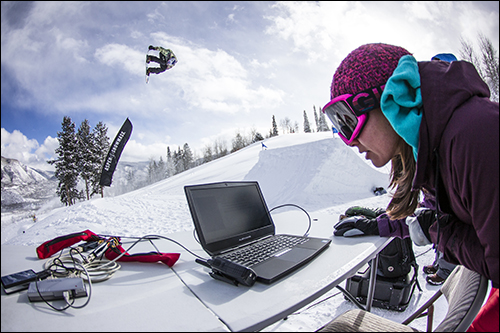The 21st annual X Games took place in Aspen at the end of January, and I’ve finally watched some of the recorded coverage. It’s not something I do often—I generally prefer being on my snowboard to watching far younger, better athletes compete. But when Intel announced last month, at the Consumer Electronics Show, that it would be using a sensor module, mounted to competitors’ snowboards and containing Intel’s Curie chip, to track riders’ speed, rotation and other statistics in real time, I was pretty stoked.
What makes this device, about the size of a hockey puck, technologically interesting is that Curie processes the sensor data and serves it up instantly, transmitting it to receivers (which were mounted along the X Games courses) over Bluetooth. This real-time availability might not be of great value to the snowboarders, since they’re too busy hurling themselves off jumps and sighting their landings to read the statistics, but from a spectator’s and coach’s point of view, the stats serve up great supplementary information. Plus, I would guess those athletes, along with their coaches, have been studying the sensor data and watching the corresponding footage intently since the X Games ended, as part of their training regimens.

The module contains a six-axis combo sensor with accelerometer and gyroscope, as well as a GPS receiver, a barometer and a compass. It is capable of tracking speed, height, distance, airtime, rotations, inversions (flips) and g-force. (Here is the fact sheet, in case you want to dive deeper into the specs.) During the competition, the technology was used only during the final rounds of the men’s slopestyle and big-air events. I’d like to have seen it used during the women’s slopestyle event, too. (The X Games does not have a women’s division for big air. Yet.)
In both events, only speed, distance, rotation and g-force (of landings) were conveyed to viewers in real time. With the pace of competition and the number of athletes running one after another, that is probably as much data as viewers could easily and quickly read on the screen. It may have been fun to see these stats in the halfpipe competitions, but in that event, riders do too many tricks, too quickly, to give viewers much of a chance to keep up with the stats in real time.
Art Versus Science?
I’m sure many purists would say adding real-time stats to the broadcast attaches too much technology to a sport that is more about personal expression and athleticism. And I did have some doubts about its value before watching the events. But seeing, for example, that in one of his big-air runs, Mark McMorris hit the lip of the jump at 40 miles per hour, flew 80 feet 4 inches and rotated 1,620 degrees before landing with 13 Gs of impact did nothing to detract from the beauty of his switch backside triple cork 1620, for which he won the silver medal. (“Switch” means you start the jump in your non-dominant or un-natural direction; “backside” means you start spinning with your back facing downhill—as opposed to your chest, which is front side—and “cork” is an aerial spin with your body’s axis leaning to the side, instead of being completely vertical.)
The X Games judges were not privy to the sensor data during the events, and that was a good call, because the riders should be judged for their style, which numbers can’t capture, as much as their technical prowess, which the judges are experienced enough to assess visually.
Looking Ahead
If you’re a baseball fan, you’ve likely seen Major League Baseball’s ability to quantify every twist of the ball through sophisticated video-capture capabilities inside ballparks. And you’ve likely seen similar on-screen notations in football and other pro sports. I think this trend toward digital analysis is going to grow quickly as wireless sensors become more powerful, small and cheap. Intel and the X Games will likely expand their partnership and add the sensor technology to more events and disciplines at the 2017 winter X Games.
But that begs the question: How much will the technology bleed into sports and sports equipment? When an Aspen Daily News reporter asked Intel’s VP, Steven Holmes, whether the tech firm could embed a smaller version of the sensor module into a baseball, Holmes replied, “Anything is possible.” But when pressed about whether Intel is working toward that very thing, he would not comment.
What do you think about the marriage of pro sports and the IoT? Does it improve, degrade or do nothing for the fan experience? Tweet me your take @iotjrnl.
Mary Catherine O’Connor is the editor of Internet of Things Journal and a former staff reporter for RFID Journal. She also writes about technology, as it relates to business and the environment, for a range of consumer magazines and newspapers. Alas, her most impressive trick is a frontside 180 with a few inches
of air.


